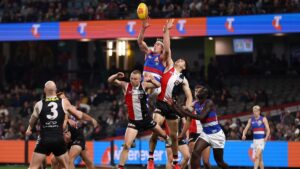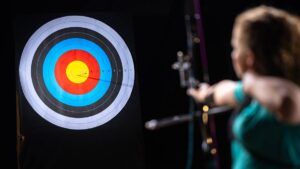Who’s leading the race to join Lynas as Australia’s next supplier of rare earths?

Pic: Schroptschop / E+ via Getty Images
Governments around the world are scrambling to shore up supply chains for rare earths given their vital role in a variety of defence applications, in the manufacture of electric vehicles and wind turbines and in other technologies that support our modern lifestyle.
The problem is China currently exerts control over most of the global rare earths supply chain. For the rest of the world, such a heavy reliance on a single country, particularly one like China that doesn’t mind leveraging its dominance when it suits its broader agenda, is unhealthy.
Lynas Corporation (ASX: LYC) has overcome significant challenges to establish itself as the world’s only big, vertically integrated supplier of rare earths outside of China, sending rare earths-rich mineral concentrate from its mine site in Western Australia to Malaysia for processing into saleable rare earth oxide products.
But even the supply from Lynas has not been without disruption and uncertainty, with the Malaysian government taking issue with the low-level radioactive waste generated from processes undertaken at the plant in Kuantan Province and ordering the company to come up with a solution or face closure.
So which of the rare earths hopefuls on the ASX are best positioned to match Lynas’ feat of bringing on a new ex-China source of supply and help ease some of the concerns around these critical minerals?
Although it is not easy to say definitively as there are several different models being pursued, Stockhead has taken a look at some of the leading contenders.
Arafura’s 100%-owned Nolans neodymium-praseodymium (NdPr) project near Alice Springs in the Northern Territory is regarded as one of the most advanced rare earth projects owned by an ASX-listed entity.
Arafura has completed a feasibility study on Nolans which included extensive flow sheet pilot testing; received Territory and federal environmental approvals; reached an agreement over Native Title with the traditional owners; and has been granted mining tenure by the NT government.
In July, the federal government also renewed Major Project Status for Nolans.
The project is essentially “shovel-ready” but for the small matters of lining up offtake partners and securing approximately $1 billion in funding, processes that tend to go hand-in-hand and are being worked through currently.
On the funding front, the company says discussions are progressing constructively with Export Finance Australia (EFA) and the Northern Australian Infrastructure Facility (NAIF), and has been encouraged by the recent importance placed on critical minerals processing and advanced manufacturing by the federal government.
The company has also stepped up its engagement with potential offtakers and financiers in Europe and elsewhere outside China.
An agreement with EFA, NAIF or both would potentially serve as an endorsement for other funders, including foreign export credit agencies (ECAs), to back the project.
Further strength in the price of NdPr oxide – which has been rising in recent months following escalating geopolitical tensions, firming pricing policy from China and market imbalance – will also benefit Arafura in financing the project.
There’s no issue with mine life around Nolans, with the project’s mining inventory supporting 39 years of production following an ore reserves upgrade delivered in March this year.
Based on average forecast annual production of 4,325 tonnes of NdPr oxide, Nolans could supply 5-10% of global demand from rare earth permanent magnet manufacturers.
Australian Strategic Materials (ASX: ASM)
Like Arafura, ASM has all the necessary approvals for its Dubbo project in New South Wales, which hosts a large in-ground polymetallic resource of zirconium, rare earths, niobium hafnium and tantalum; it just needs to find the funding to get it built.
The capital cost estimate provided in June 2018 was $1.3 billion for a single 1Mtpa plant or $808 million for an initial 500,000tpa development followed by a second stage expansion (at further cost) to 1Mtpa.
In a joint venture with South Korea’s Zirconium Technology Corporation (Ziron Tech), ASM is looking at going further down the value-add path and producing rare earth (and other specialty) metals using outputs from Dubbo.
This move may aid the company in finding funding support from government agencies such as EFA, which has confirmed an interest in potentially participating in a financing consortium for the project.
The global mining resource at Dubbo supports more than 75 years of production at nameplate capacity of 1Mtpa so again there are no concerns around mine life.
Currently valued at around $460 million, ASM carries the highest market capitalisation of all the ASX-listed rare earths companies outside of Lynas.
Technically Australia’s second rare earths miner, Northern Minerals is producing a mixed rare earth carbonate (MREC) product through a large pilot plant at its Browns Range project in Western Australia.
But it remains unclear when the company might take the next step to establish a commercial-scale operation at Browns Range.
Exploration is underway with the aim of increasing the Browns Range mineral resource and the life of mine potential, with $5 million allocated towards this goal this financial year.
According to the company, the commitment to exploration over the next nine months is designed to underpin its “ongoing ambition to realise the potential of Browns Range beyond the Pilot Plant Project”.
Work is also being done to investigate separating the MREC produced at Browns Range into individual heavy rare earth oxides, which would increase the price Northern Minerals receives.
The company currently sells its product into China through German trading house thyssenkrupp Materials Trading.
A leadership change took place earlier in the year, with long-time managing director George Bauk standing down and chief financial officer Mark Tory taking over.
Peak Resources completed a feasibility study on its Ngualla rare earths project in Tanzania and associated UK refinery, from which it plans to produce a separated NdPr oxide, in April 2017.
Results of optimisation work increasing the design capacity of the project were released to the market in October of that year.
The UK refinery is fully permitted but the company is still awaiting a Special Mining Licence (SML) from the Tanzanian government before it can move forward with securing funding to build Ngualla.
Peak says discussion and interactions with all levels of Tanzanian government continue to be positive and that the SML is now only contingent on Cabinet approval.
The company has also been buoyed by the resolution of the tax dispute between the government and Barrick Gold and the apparent indications that Tanzania is committed to reinvigorating its mining sector after a few difficult years.
Given that some time has passed since the completion of feasibility, it may need updating, but the capex figure provided back then was $US365 million for a project producing 2,810 tonnes of NdPr oxide a year.
Peak has also undergone recent leadership changes, with chairman Peter Meurer retiring and CEO Rocky Smith stepping down. Tony Pearson has taken over the chairman’s role in an acting capacity, while Smith’s duties are being shared by the directors and executive team.
Hastings Technology Metals (ASX: HAS)
Hastings caught the eye in June when it announced a “Master Agreement” with Germany’s Schaeffler Technologies to supply a “substantial volume” of MREC from its Yangibana project in WA’s Gascoyne region over an initial period of 10 years.
Schaeffler, which is seeking to develop an independent supply chain for its e-motor business for the emerging electric vehicle industry, is an offtake partner most ASX-listed rare earths companies would love to lay claim to.
Hastings also has a MoU in place with thyssenkrupp relating to the marketing of MREC from Yangibana.
It is aiming to convert both MoUs to binding offtake contracts by the end of 2020 before declaring financial close and making a final investment decision on Yangibana mid-next year.
The project has a proposed start date of 2023, but Hastings is yet to settle on a new site for the process plant, while the company has been drilling with a view to extending the current mine life of 13 years.
A capital cost of $516 million including contingency has been estimated, with Hastings claiming to be well progressed with lining up concessionary senior debt through German, Finnish and Australian government agencies.
The company raised $20.7 million in equity in September, with the funds earmarked for procuring equipment, further engineering design and drilling to increase mining reserves.
Vital is aiming to be the ASX’s next rare earths producer through its staged approach to development of its Nechalacho project in Canada’s Northwest Territories.
The approach is based on the premise that prior to accepting large volumes of feedstock from a new supplier, customers require a transition period to incrementally increase the volume of feedstock accepted through their separation facilities.
Vital is in bed with the Saskatchewan Research Council and plans to build its extraction plant producing MREC adjacent to a separation plant producing commercial grade separated rare earth oxides.
The extraction demonstration plant would cost an estimated A$5.25 million with Vital aiming to commence processing operations in the September quarter next year.
Greenland shares have surged since the middle of the year as the company has moved forward with the environmental approvals process for its Kvanefjeld project in Greenland.
News that the Kvanefjeld Environmental Impact Assessment has met the requirements to be released for public consultation has helped propel the company to a market capitalisation of almost $350 million.
Shenghe Resources Holding Co, a leading Chinese rare earths company that supplies end-user industries with high purity rare metals and oxides and one of the new owners of the Mountain Pass rare earths mine in California, owns 10.5% of Greenland.
RareX is a rare earths company – it owns 100% of the Cummins Range project in WA’s Kimberley region and other rare earths assets – that comes with a side of exposure to copper-gold exploration hotspot, the Lachlan Fold Belt in New South Wales.
Cummins Range has a JORC resource of 13Mt grading 1.13% total rare earth oxide and RareX has recently completed a 6,000m-plus drilling programme that produced some near-surface, high-grade results that should form the basis of a resource upgrade in early 2021.
The company’s “low capex” approach is to produce a saleable rare earths-rich monazite mineral concentrate to sell into China and it is working with Noble Group subsidiary Talaxis on refining this strategy.
Ionic is in the exploration phase with its 51%-owned Makuutu rare earths project in Uganda, where it has been drilling hard and recently submitted an application to expand its landholding.
Ionic believes the geology at Makuutu sets it apart from other ASX-listed rare earths companies.
It is an ionic clay-type deposit similar to those found in southern China, which are considered the world’s cheapest and most readily accessible sources of heavy rare earths.
They typically require less complex processing to produce a mixed intermediate rare earth concentrate.
At Stockhead, we tell it like it is. While Arafura and Ionic are Stockhead advertisers, they did not sponsor this article.
Related Topics

UNLOCK INSIGHTS
Discover the untold stories of emerging ASX stocks.
Daily news and expert analysis, it's free to subscribe.
By proceeding, you confirm you understand that we handle personal information in accordance with our Privacy Policy.








